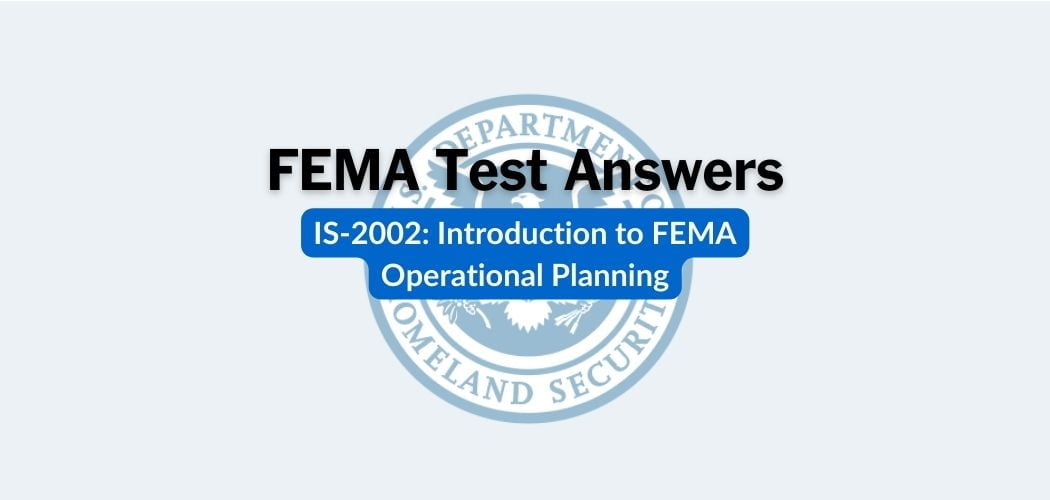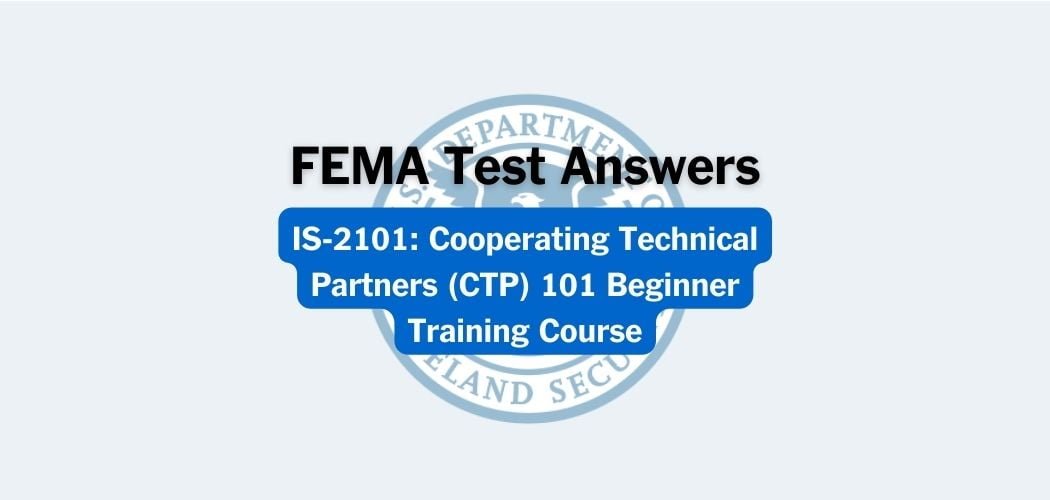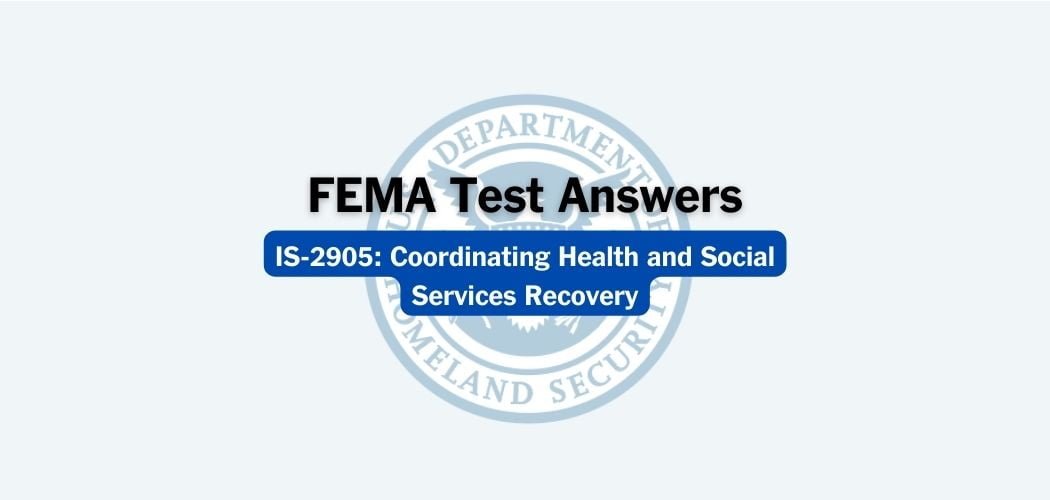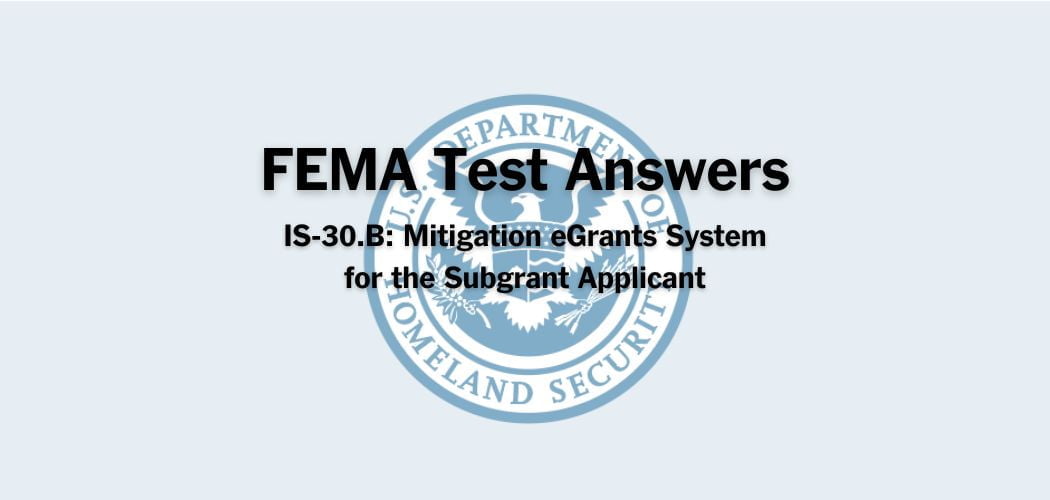Overview: The new FEMA IS-18.24 course was updated on January 4, 2024 to present the underlying principles of equal employment opportunity and recognizes FEMA’s commitment to ensuring equal employment opportunity (EEO) for all current and prospective employees.
By the end of the FEMA IS-18.24 course, participants will be able to describe how diversity benefits FEMA, explain FEMA’s commitment to equal rights, recognize actions that constitute discrimination, identify laws that protect Federal employees, and describe the EEO complaint process.
FEMA IS-18.24 test answers
Each time this test is loaded, you will receive a unique set of questions and answers. The test questions are scrambled to protect the integrity of the exam.
Question 1. If an employee feels he or she has been the victim of unlawful discrimination, that individual must initiate contact with an EEO Officer within how many days of the occurrence of the alleged discriminatory act?
A. 15 days
B. 45 days✅
C. 60 days
D. 90 days
Question 2. Tom, a supervisor, calls a team meeting and asks Mary, the only woman on the team, to take notes and make copies of a memo for team members who are her peers. In previous meetings, he asked her to make coffee. Mary complains to an EEO Counselor. Which of the following statements is true?
A. These peripheral requests are not a sufficient basis for a complaint. An EEO complaint must relate to the essential functions of a job.
B. Because her peers were not asked to do the menial tasks, Mary may have grounds for a complaint of sex discrimination under the Equal Pay Act.
C. Because of the sexist treatment from her supervisor, Mary may have grounds for a complaint of sex discrimination under Title VII.✅
D. Tom should not have asked only Mary to do these things; however, it is solely Mary’s responsibility to ensure her boss treats her fairly.
Question 3. EEO Counselors are responsible for assisting employees who allege they have been discriminated against, helping employees and supervisors resolve potential EEO matters, and:
A. Notifying supervisors if their employees are being discriminated against.
B. Helping a supervisor determine if someone is the most qualified person for a job.
C. Serving as a neutral party during the EEO complaint process.
D. Deciding if an EEO claim is valid based on EEO laws and regulations.✅
Question 4. During the informal stage of the EEO complaint process, the Complainant may opt to use EEO counseling or he or she may:
A. Bring the case before an Administrative Judge.
B. Use Alternative Dispute Resolution if it is offered.✅
C. Hire a lawyer and sue FEMA in Federal court.
D. File a formal complaint with the EEOC.
Question 5. After receiving the Notice of Right To File a Discrimination Complaint, the Complainant has how many days to file a formal complaint?
A. 7 calendar days
B. 15 calendar days✅
C. 60 calendar days
D. 90 calendar days
Question 6. Martha and Rose work in the same office and have worked on several projects together. Martha, a middle-aged African-American woman, was surprised when Rose, a young white woman, was given a supervisory position for which Martha thought she was more qualified. Rose has worked for FEMA for only a short time. In order to minimize the potential of a charge of age and/or race discrimination, Rose’s supervisor should:
A. Tell Martha she will be considered for the next supervisory opening.
B. Prepare statistics to show an increase in minority promotions over the past 5 years.
C. Have records proving Rose was better qualified for the job.✅
D. Tell Martha, she doesn’t have the right attitude and leadership skills to be a supervisor.
Question 7. _____ on the basis of race, color, religion, sex, national origin, disability, age, or genetic information is illegal.
A. Mentoring
B. Networking
C. Accommodation
D. Harassment✅
Question 8. The Rehabilitation Act of 1973, Americans with Disabilities Act (ADA) of 1990, and ADA Amendments Act of 2008 protect persons with which of the following conditions?
A. Disorders from current illegal drug use
B. Compulsive gambling
C. Pyromania
D. HIV✅
Question 9. After the Complainant files a formal complaint, within how many calendar days must the EEO investigation be completed?
A. 30 days
B. 60 days
C. 90 days
D. 180 days✅
Question 10. After receiving a request for a final agency decision, how many days does the agency have to issue its decision?
A. 15 days
B. 30 days
C. 60 days✅
D. 90 days
Question 11. Which of the following is NOT a reasonable accommodation?
A. Providing a modified work schedule structured around an employee’s physical therapy.
B. Providing a large-screen computer monitor for a visually impaired employee.
C. Construct a wheelchair ramp to accommodate an employee in a wheelchair.
D. Exempting an employee with a disability from performing essential functions of the job.✅
Question 12. One of your subordinate employees, Timothy, worked extra hours on Tuesday and Thursday so he could attend Ash Wednesday services at his church. Which of the following statements is true?
A. This situation is only problematic if a colleague complains about Timothy’s absence Wednesday or is offended by the
ashes on his forehead.
B. Permitting Timothy to make up time lost due to the observance of religious practices is a reasonable religious accommodation.✅
C. Supervisors can use individual discretion when deciding whether to allow a subordinate to adjust his work schedule for religious practices.
D. Timothy should have taken personal leave in order to miss work to attend religious services during his scheduled work time.
Question 13. A supervisor was interviewing a female applicant for a position that would require extensive out-of-town travel to rough areas. The supervisor commented that “as a woman,” she probably would have trouble with the travel “because it is dangerous.”
A. The supervisor, after telling the woman of the job requirements and locations, should have allowed her to decide if she wanted the position.✅
B. The supervisor was acting in accordance with FEMA’s safety policies in warning the woman that she wouldn’t want to travel to dangerous locations.
C. The supervisor isn’t allowed to say anything about the danger of the territory, and should simply choose the best-qualified applicant for the job.
D. The supervisor should not have interviewed the woman for the job in the first place if it was too dangerous for a woman to do it.
Question 14. While deployed to a disaster operations center, an employee informs a supervisor that they have a medical condition and requires some sort of adjustment to their normal work routine. What should the supervisor do?
A. Explain to the employee that discussing medical conditions in the workplace is sensitive and probably should be left up to professionals to figure out.
B. Explain to the employee that you have the same medical condition, and you do not require any accommodations, so you do not believe they need one either.
C. Recommend that the employee meets with the FCO to discuss the matter further.
D. Determine if there is something that can be done to accommodate the employee. Contact the deployed Equal Rights Officer or the Disability Employment Program Manager at HQ for further assistance.✅
Question 15. Which of the following is an example of discrimination under Title VII?
A. Discrimination based on unequal pay.
B. Discrimination on the basis of age.
C. Discrimination on the basis of race or national origin.✅
D. Discrimination on the basis of physical or mental impairment.
Question 16. If an employee at Headquarters feels that he or she has been discriminated against, he or she should inform:
A. The Office of Equal Rights.✅
B. His or her immediate supervisor.
C. All co-workers in his or her work unit.
D. The Equal Employment Opportunity Commission.
Question 17. After a complaint is investigated, the Complainant may either request a final agency decision or:
A. Appeal to the EEOC for reconsideration.
B. Request an EEOC hearing and decision.
C. Participate in counseling with an EEO Counselor.✅
D. Refile a formal complaint.
Question 18. Cathy, a supervisor, asks Bob, one of her employees, to go out with her on several occasions. Each time, Bob refused. When training opportunities became available, Bob requested training. Although other employees were allowed to take training, Cathy refused to approve Bob’s request. The actions on the part of Cathy, the supervisor, may constitute sexual harassment.
A. True✅
B. False
Question 19. Section 508 of the Rehabilitation Act requires Federal agencies to:
A. Provide to employees and the general public comparable access; and use of information and services for people with and without disabilities.✅
B. Post on their public Web sites statistical data relating to EEO complaints filed against the Agency.
C. Pay women and men comparable wages for work performed that is of similar skill, effort, and responsibility.
D. Accommodate the religious practices of employees and prospective employees unless it would pose an undue hardship on the employer.
Question 20. According to the Age Discrimination and Employment Act, at what age does an employee fall into the age-protected class?
A. 39
B. 40✅
C. 50
D. 65
Question 21. Who is responsible for demonstrating the existence of unlawful discrimination by a preponderance of the evidence?
A. EEO Officer
B. Complainant✅
C. FEMA Office of Equal Rights
D. Supervisor
Question 22. Which statement below is false as it pertains to mediation (a form of Alternative Dispute Resolution)?
A. A trained neutral party conducts the mediation session(s).
B. A mediator helps the parties work toward reaching a mutually acceptable resolution.
C. Mediation can occur at various times during the EEO complaint process.
D. All employees who file an EEO complaint must go through mediation.✅
Question 23. Who is responsible for issuing decisions on EEO complaints?
A. Administrative Judge✅
B. EEO Officer
C. Neutral assigned to mediate the complaint
D. Equal Employment Opportunity Commission
Question 24. If the Complainant is not satisfied with the results of the final agency decision, then he or she may file a civil action in Federal court. The filing must take place within how many days of receipt of the decision?
A. 15 days
B. 30 days
C. 60 days
D. 90 days✅
Question 25. The No FEAR Act protects employees from:
A. Age discrimination.
B. Sexual harassment.
C. Reprisal discrimination.✅
D. Racial harassment.
Question 26. After receiving the Report of Investigation, how many calendar days does the Complainant have to request either an EEOC hearing or a final agency decision?
A. 10 calendar days
B. 15 calendar days
C. 30 calendar days✅
D. 60 calendar days
Other recurring FEMA courses
These courses currently have a “calendar-year” extension to allow FEMA staff to retake the course as a recurring requirement.
- IS-19.24: FEMA EEO Supervisor Course 2024
- IS-20.24: Diversity Awareness Course 2024
- IS-21.24: Civil Rights and FEMA Disaster Assistance
- IS-35.24: FEMA Safety Orientation 2024
- IS-37.24: Managerial Safety and Health
- IS-107.24: FEMA Travel Rules and Regulations 2024
- IS-246.24: Implementing the Federal Priorities and Allocations System (FPAS)



